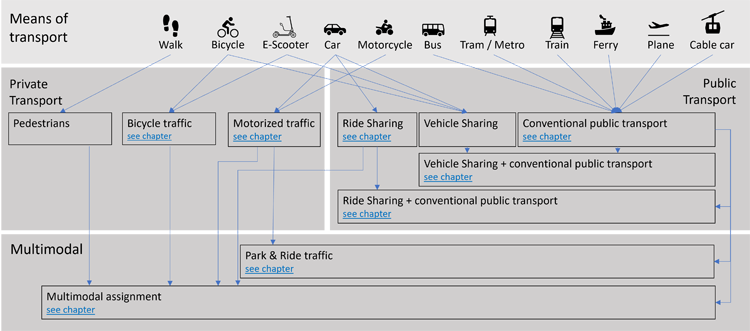Network model – the transport supply
A network model representing the comprehensive transport system must describe the spatial and temporal structure of the transport supply. For this reason, the network model consists of several network objects which contain relevant data about the link network, lines, timetables, and traffic zones. The most important network object types in Visum are described here.
- Zones (also called traffic cells) describe areas with a particular land use and their location in the network (for example residential areas, commercial areas, shopping centers, schools). They are the origin and destination of trips within the transport network, which means zones and the transport network are connected through connectors.
- Nodes are objects which define the position of intersections in the link network and switches in the railway network. They are the start and end points of links.
- Links connect nodes and thus describe the structure of the road and rail network. A link has a particular direction so that the opposite link represents a separate network object.
- Turns indicate which turning movements are permitted at a node and store the turning time penalty.
- Connectors connect zones to the link network. They represent the access and egress distances to be covered between a zone’s center of gravity and the nodes/stops of the network.
- Stops are subdivided into stop areas and stop points served by lines where passengers may board or alight.
- Lines that are listed with a name in a timetable usually go in both directions. A line can consist of several line variants, so-called line routes which differ for example, in their route courses. Line routes describe the spatial course of line services, for each line route one or several time profiles can be defined.
- Territories are network objects which can be used, for example, to illustrate districts or counties. Based on a polygon that defines the territorial border, PrT and PuT indicators for regular or single PuT line services can precisely be accounted for each territory.
Every network object is described by its attributes. Attributes can be subdivided as follows:
- Input attributes such as link length or link number.
- Calculated attributes (output attributes) such as boarding passengers at a stop or the number of assigned vehicles. They are only filled with values in the course of calculation procedures.
The integrated network model distinguishes between transport systems of the private transport and the public transport type. These types reflect the form of organization. Private transport road users use their own means of transport. Therefore, they can freely choose the departure time and route. The travel time depends on the permissible speeds of the links.
Public transport road users use the supply of a service provider who provides vehicles and defines the conditions of transportation. Passengers do not use their own vehicle but pay the service provider for transportation.
Conventional public transport is characterized by a predefined network of lines (route courses and stops) and a timetable with travel times and departure times.
Flexible forms of service, such as ride sharing or vehicle sharing services, provide the means of transportation. These do not follow a fixed line network or timetable. A fleet of vehicles provided by the operator is intended to flexibly meet the mobility needs of road users. The temporal and spatial availability of the vehicles define the access and wait time and thus essential quality characteristics of the service.
Vehicle sharing systems are characterized by the fact that the user borrows a vehicle exclusively and transports himself to the destination as the driver.
In the case of ride sharing services, the user is picked up by a vehicle and shares it with other passengers for part of the journey, if necessary. This involves passengers taking detours to pick up or drop off other passengers.
Means of transport can be assigned to different transport systems. Thus, the privately owned car is classified as private transport but can be classified as public transport when used as a shared cab within a ride sharing fleet. A bus in regular service is the classic example of public transport. The chartered coach is allocated to the private transport.
Illustration 2 shows the allocation of various means of transportation to transportation systems of the type private transport and public transport. You will find information about modeling in Visum in the

Illustration 2: Allocation of means of transport to transport systems

